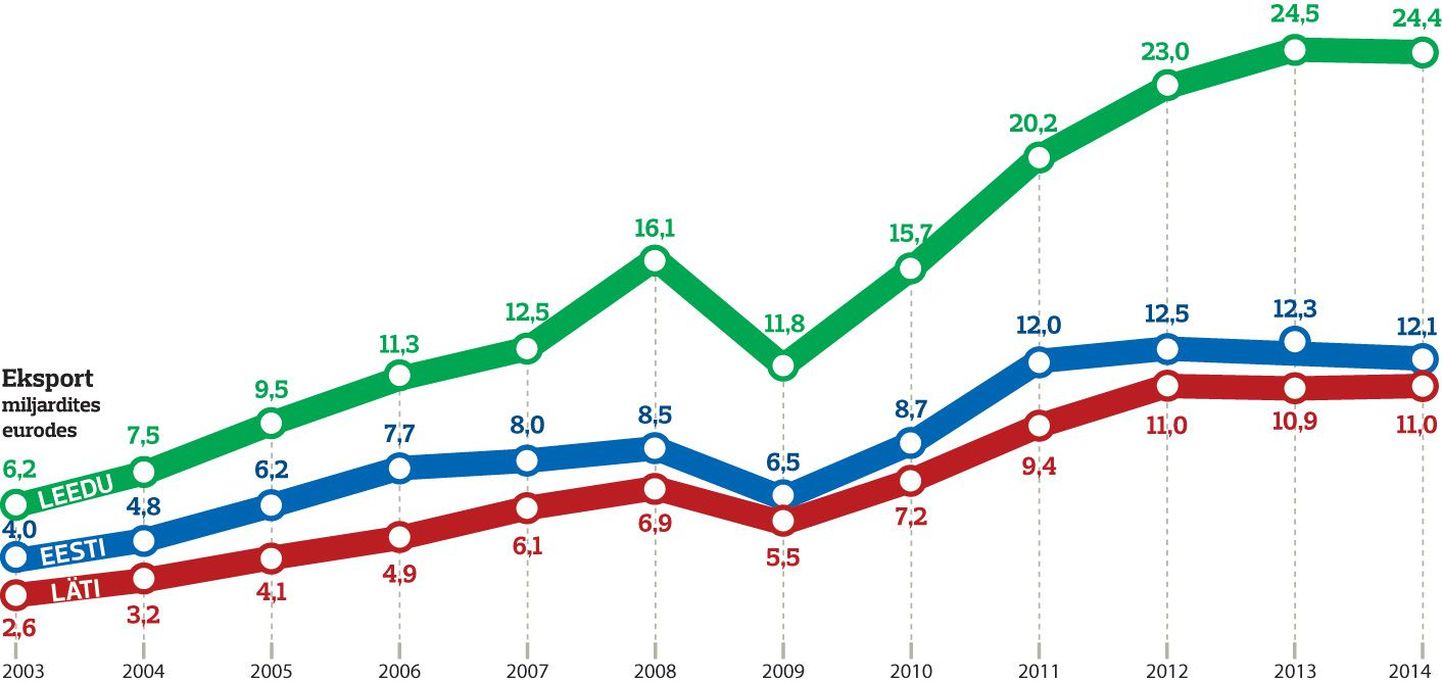
Two summers ago as it was already known that Latvia was joining the euro, consultancy EY Estonia head Ivar Kiigemägi predicted this was Estonia's last year with fastest growth in eurozone. He was right.

Two summers ago as it was already known that Latvia was joining the euro, consultancy EY Estonia head Ivar Kiigemägi predicted this was Estonia's last year with fastest growth in eurozone. He was right.
Back then, we were among the few bright spots on the map of Europe groaning under its debt crisis. Unlike other eurozone nations, Estonia’s public debt was next to nonexistent. In addition to our rapid and relatively painless exit from the financial crisis, and to the fact that no bank needed to be bailed out and that, largely thanks to having joined the euro in 2011 ahead of the other Baltics, we were showing a fastest economic growth in the euro area. (True, the rapid growth had been preceded by a fastest economic decline in Europe during the financial crisis – this is what is continually being forgotten.)
Estonia’s advantage before the other Baltics – using the world’s second largest currency – lasted for three years. Then Latvia switched to the euro, and Lithuania a year after that. Now, Estonia has lost its currency edge before the neighbours, and economic growth records are being set south of the border. The former Baltic tiger has turned into the Baltic laggard.
We undertook to compare three economic indicators of greatest effect on wellbeing to people in the three Baltics: gross domestic product (GDP), gross domestic product per inhabitant, exports, and direct foreign investments. Turns out, in growth we are lagging behind the neighbours to our South.
«It must be admitted that almost in every one of these indicators, our formerly rather large advantage ahead of the neighbours has shrunk or totally disappeared,» said LHV bank economist Heido Vitsur. «In mid-term, Lithuanian and Latvian exports are growing a lot faster than ours. As the growth tempo of the three of us is largely linked to export capacity, it is totally logical that Estonia’s advantage in GDP per person is inclined to diminish.»
«Perhaps a largest difference in the past five year statistics is GDP per person where Lithuanian has grown much more than us,» added EY Estonia chief Ivar Kiigemägi. «But when it comes to the GDP change, it may be concluded that largely the change is due to their greater emigration as compared to us.»
Estonia’s slower growth is also seen in the recently published Eurostat third quarter economic growth data: Estonia 0.5 percent; Lithuania 1.8 percent; and Latvia a whopping 2.5 percent.
Likewise, the future looks brighter for the latter two. According to European Commission’s fresh economic forecast, Estonian economy will in 2016 and 2017 grow by 2.6 percent; Latvia’s growth will be 3.0/3.3 percent and Lithuania’s 2.9/3.4 percent. Faster-than-Estonian economic growth is also predicted to the Southern neighbours by others.
According to Mr Kiigemägi, Ernst and Young Baltic next vice year forecast shows Latvia and Lithuanian to be somewhat ahead of us, while the differences aren’t large (average five-year difference being 0.5–0.7 percentage points).
The reasons why in comparison to the other Baltics we have lost speed are many.
«One reason is simple: there is no special reason why the neighbours should always lag behind us in their tempo of development – seeing we share similar foundational conditions to develop our economies,» explained Heido Vitsur.
But in addition to the similar basic conditions, there are those created by the state itself.
«It seems to me that it is here where the neighbours have been more successful than us, this past decade,» said Mr Vitsur. «They have been more innovative in shaping their business environment, have taken more risks and more swiftly to adapt to the global economic environment, and have marketed themselves more actively or more successfully than we. They have not clung to the mistaken principle of «we may not alter the economic policy which brought us success», but have built on the understanding that in the changing world one must continually change to keep current.»
Nordea bank chief economist Tõnu Palm says the difference in growth tempo is largely due to the Southern neighbours investing more in boosting domestic demand. Meanwhile, all three are experiencing declining exports at the moment.
«For example, Lithuania’s economic growth has remarkably been boosted by investments related to domestic market. Last year, the construction sector input was almost a percentage point of GDP, and even in first half of this year decent growth continued as supported by investments into real estate and infrastructure,» said Mr Palm. «However, domestic demand is mirrored in budget and current account deficits, and in governmental investments which grow more forcefully than in Estonia. Thus, it is partly an issue of economic policy options.»
The expert said Latvia and Lithuanian have had a higher percentage of exports into Germany and Poland. «Definitely, Estonia might look more towards Germany, but also towards the UK. The development trend for all Baltics is increasing exports into the EU, and added variety to export markets with new growing markets,» he advised.
EY Estonia’s Ivar Kiigemägi said Estonia’s situation as compared to the other Baltics must not be overdramatized.
«Rather often, we are the most critical regarding ourselves. Every time I share the criticism with my Latvian and Lithuanian colleagues, they rather set us as an example in several issues and offer praise,» said Mr Kiigemägi. «We got the joining-the-euro gains earlier, now Latvia and Lithuania are enjoying the same,» he said, adding a reason.
Nordea’s Tõnu Palm said that the Baltics broadly develop in step, economically, and if one should be lauded, it would be Lithuania.
«In Lithuanian re-exports, Russia’s share was large, but despite that they have done rather nicely,» said Mr Palm.